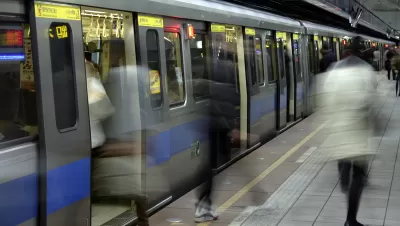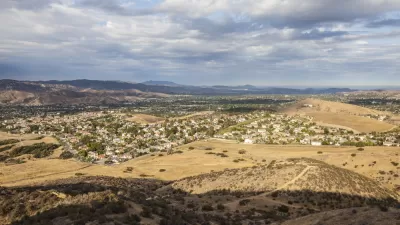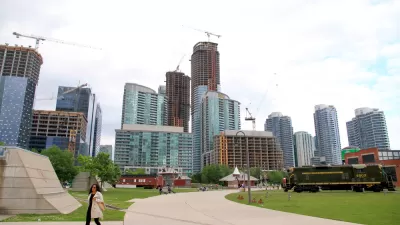This post critiques a common argument against federal support for public transit: that transit gets 20 percent of transportation spending yet has a much lower market share.

I just received a email newsletter raising the decades-old argument that public transit gets too much federal support because transit gets 20 percent of federal funding for surface transportation, but its share of trips and transportation mileage is far lower.
One obvious retort to this argument is environmental: highway spending, by encouraging automobile travel to car-dependent places, increases vehicle miles traveled (VMT), thus increasing pollution—not just greenhouse gas pollution, but also more heavily regulated types of pollution such as carbon monoxide and particulate matter. To the extent that highway spending increases such social harms, one dollar of spending may be one dollar too much, let alone the tens of billions of dollars currently devoted to roads.
In addition, highway spending can create other negative side effects: for example, where jobs track new highways but public transit does not, a "spatial mismatch" exists between the pre-highway population and jobs; population was located in more urban areas, but the highway has shifted jobs into outer suburbs and exurbs. To the extent people react to this spatial mismatch by buying cars and driving more, they have suffered additional costs caused by government action. To the extent people too poor to buy cars cannot reach work, they have suffered an even more severe cost: the loss of job opportunities.
Furthermore, the "20 percent" argument overlooks both the impact of past spending and the existence of current non-transportation policies that effectively subsidize highways and sprawl.
In the first half of the 20th century, government at all levels spent liberally on highway, but streetcars (the leading mode of public transit in most of the United States) were a private industry, which meant that government’s job was to tax and regulate it. So in many places, roads got not only the money devoted to roads, but also the implicit subsidy that government created by taxing and regulating the competition. And over the course of the 20th century, transit received far less than 20 percent of government transportation spending.
What about the past 50 years? Even if one pretends that history began with the urban transit legislation of the 1960s, government effectively subsidizes highways and sprawl in at least two major respects: zoning and education.
As a rule, zoning effectively makes sprawl easy and infill development difficult. If a developer builds a subdivision in the middle of nowhere, it will usually be able to get government permission because there will be no neighbors around to object, and municipal legislators will thus decide that the project is noncontroversial.
By contrast, if someone wants to densify an existing neighborhood, there will be plenty of neighbors around to object. As a result, community opposition will often lead cities to reject new development, since neighbors of a project vote and the project’s potential residents and customers do not. Even where infill development is allowed, cities limit density through minimum lot size, parking and setback requirements, all of which limit the number of residences, shops or offices that can be built per acre of land.
Because transit systems tend to be centered on downtown, limitations on infill development force new housing into areas that are automobile-dependent. Thus, zoning laws encourage driving and discourage transit use, thereby increasing VMT and increasing gas tax revenue. Thus, the costs of zoning are an (admittedly nonquantifiable) subway for highways.
The public education system similarly subsidizes highways. American school attendance laws require children to attend public schools in the municipality of their residence. Municipalities which are near downtown (and thus likely to have the best transit service) tend to be demographically diverse. Because the public education system tends to have difficulty educating children from disadvantaged backgrounds, such jurisdictions tend to have less prestigious public schools than car-oriented suburbs. Thus, American parents are more likely to favor car-oriented places than would be the case in a nation without government-run schools (or one where school attendance zones were drawn differently), which in turn means more driving and more gas tax revenue. This subsidy too is difficult to quantify, because not all government spending on education is on prestigious suburban schools.
In sum, government favors driving in a wide variety of ways beyond current spending on highways. As a result, the real amount of social spending and regulation favoring driving is far beyond the billions of dollars currently spent on highways, which in turn may mean that the real “spending gap” between highways and transit may exceed the 4-1 ratio between highway and transit spending.

Manufactured Crisis: Losing the Nation’s Largest Source of Unsubsidized Affordable Housing
Manufactured housing communities have long been an affordable housing option for millions of people living in the U.S., but that affordability is disappearing rapidly. How did we get here?

Americans May Be Stuck — But Why?
Americans are moving a lot less than they once did, and that is a problem. While Yoni Applebaum, in his highly-publicized article Stuck, gets the reasons badly wrong, it's still important to ask: why are we moving so much less than before?

Using Old Oil and Gas Wells for Green Energy Storage
Penn State researchers have found that repurposing abandoned oil and gas wells for geothermal-assisted compressed-air energy storage can boost efficiency, reduce environmental risks, and support clean energy and job transitions.

Updating LA’s Tree Rules Could Bring More Shade to Underserved Neighborhoods
A new USC study finds that relaxing Los Angeles’ outdated tree planting guidelines could significantly expand urban tree canopy and reduce shade disparities in lower-income neighborhoods, though infrastructure investments are also needed.

California's Canal Solar Projects Aim to Conserve Resources and Expand Clean Energy
California’s Project Nexus has begun generating electricity from solar panels installed over irrigation canals, with researchers and state agencies exploring statewide expansion to conserve water and boost clean energy production.

HHS Staff Cuts Gut Energy Assistance Program
The full staff of a federal program that distributes heating and cooling assistance for low-income families was laid off, jeopardizing the program’s operations.
Urban Design for Planners 1: Software Tools
This six-course series explores essential urban design concepts using open source software and equips planners with the tools they need to participate fully in the urban design process.
Planning for Universal Design
Learn the tools for implementing Universal Design in planning regulations.
Heyer Gruel & Associates PA
City of Moreno Valley
Institute for Housing and Urban Development Studies (IHS)
City of Grandview
Harvard GSD Executive Education
Salt Lake City
NYU Wagner Graduate School of Public Service
City of Cambridge, Maryland





























